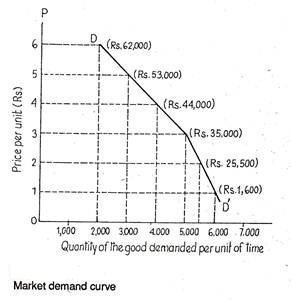The demand function shows the relation between the quantity demanded of a commodity by the consumers and the price of the product. These functions are probably the most important tools used by economists. While many variables determine the quantity consumers wish to purchase in a market, the price of the commodity is perhaps the most important one.
In this context, we may distinguish between individual demand and market demand. The former refers to the quantity of a good that an individual stands ready to buy at each of several prices, at a particular time, under given conditions.
The latter consists of the total quantity of a good that would be bought in the aggregate by individuals and firms, at each of the various prices, at a fixed point of time. The demand schedules may be graphed or shown in a tabular form. When a demand schedule is graphed, it is called the demand curve.
A demand function is a list of prices and the corresponding quantities that individuals are willing and able to buy at a fixed point of time. We may note at the outset that demand is a function (or schedule), not a specific quantity. It is formally defined as a schedule of the total quantities of a commodity or service that will be purchased at various prices at a particular point of time.
Hence when we refer to the demand for meat or the demand for motors cars in India, we are considering the amounts that consumers are willing and able to purchases at various prices.
The word ‘demand’ is a broad concept referring to the entire schedule of quantities and prices. But the term ‘quantity demanded’ refers to a single point on the demand schedule or curve. It shows the maximum quantity demanded at a particular price.
We generally specify consumer demand in any of the three ways: as a schedule, a graph, or a function. This table shows the list of prices and the corresponding quantities that the consumers demand per unit of time (a day or a week).
|
Market Demand Schedule |
|
| Quantity demanded
(Units) |
Price per Unit (Rupees)
Rs. |
| 2,000 | 6 |
| 3,000 | 5 |
| 4,000 | 4 |
| 5,000 | 3 |
| 5,500 | 2 |
| 6,000 | 1 |

Quite often it is more convenient to work with the graph of a demand schedule, called a demand curve, rather than with the schedule itself. Figure shows the demand curve which is a graphical representation of the demand schedule presented in Table. Each price-quantity combination (Rs. 6, 2,000), (Rs. 5, 3,000), and so on is plotted. The locus of such points (each one showing a particular combination of p and q) DD’ is the demand curve.
The demand curve indicates the quantity of the good consumers are willing and able to buy at a fixed point of time at alternative prices, i.e., at every price from Rs. 6 to Rs. 1. Since price and quantity demanded are inversely related, the curve slopes downward.
Indeed, all market demand curves (which are arrived at by adding up demand curves of individual consumers) are downward sloping because of the law of demand. Individuals purchase less when price rises. Furthermore, as price increases, some individuals do not purchase anything at all, again causing the quantity demanded at each price to fall.
Alternatively, we can express demand as a function
Qx = ƒ(Px)
In this function, the other variables (income, and so on) are held constant. The quantity demanded of a commodity is a function of the price of the good, holding constant the other (proximate) determinants of demand.
One thought on “Demand Function”